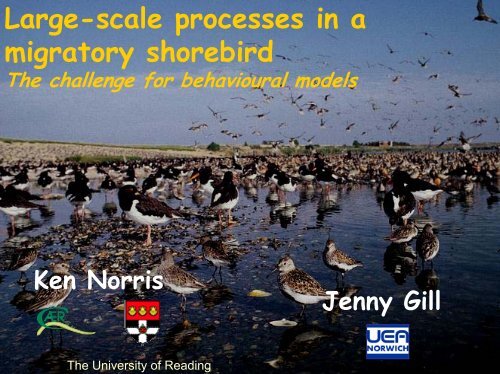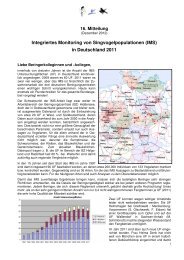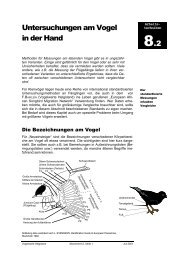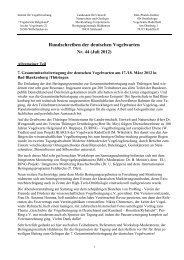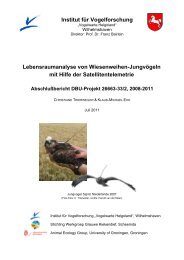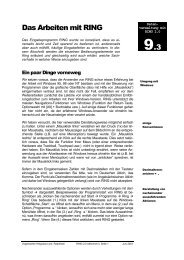PDF, 0.8 MB
PDF, 0.8 MB
PDF, 0.8 MB
Create successful ePaper yourself
Turn your PDF publications into a flip-book with our unique Google optimized e-Paper software.
The University of Reading<br />
Large-scale processes in a<br />
migratory shorebird<br />
The challenge for behavioural models<br />
Ken Norris<br />
Jenny Gill
Behavioural models<br />
• Predict distribution,<br />
demography and<br />
abundance<br />
• Behavioural dynamics<br />
of resource<br />
competition<br />
• Depletion/interference
Limosa l. islandica<br />
L. l. limosa
Behavioural models:<br />
• Do models work at small-scales?<br />
• If so, how do we move up to larger<br />
scales?
Deben<br />
Alde<br />
Orwell<br />
Stour<br />
Colne<br />
Blackwater
East coast prey<br />
Proportion in diet<br />
1<br />
0.5<br />
0<br />
Oct Nov Dec Jan<br />
Feb Mar<br />
Bivalve density<br />
Bivalves<br />
Polychaetes<br />
Unknown<br />
3000<br />
2000<br />
1000<br />
Deben<br />
Orwell<br />
Stour<br />
0<br />
Oct Nov Dec Jan Feb Mar
Resource depletion models<br />
M<br />
P = T h ∑ ( j − d c<br />
) f j<br />
+1/ a ′ ∑ f j<br />
log( j / d c<br />
)<br />
d c<br />
M<br />
d c<br />
Sutherland & Anderson 1993<br />
• Resource abundance<br />
• Functional response<br />
Intake rate<br />
Prey abundance
Resource depletion models<br />
M<br />
P = T h ∑ ( j − d c<br />
) f j<br />
+1/ a ′ ∑ f j<br />
log( j / d c<br />
)<br />
d c<br />
M<br />
d c<br />
Sutherland & Anderson 1993<br />
• Resource abundance<br />
• Functional response<br />
Intake rate<br />
3<br />
2<br />
1<br />
0<br />
0 2000 4000<br />
Bivalve density
400<br />
Patch<br />
900<br />
Mudflat<br />
225<br />
400<br />
Observed godwit-days ha -1<br />
100<br />
25<br />
0<br />
0 25 100 225 400<br />
196<br />
100<br />
Estuary<br />
100<br />
0<br />
0 100 400 900<br />
36<br />
4<br />
4 36 100 196<br />
Predicted godwit-days ha -1<br />
Gill et al. (2001) Proc. Roy. Soc. B
Intake rates and prey density predict:<br />
• Current godwit distribution at smallscales<br />
• Can we use the same framework to<br />
describe distribution at larger spatial<br />
scales?
100<br />
Population index<br />
80<br />
60<br />
40<br />
20<br />
0<br />
70 74 78 82 86 90 94 98<br />
Year<br />
Source: Wetland Bird Survey
100<br />
101-1000<br />
> 1000<br />
Black-tailed Godwit<br />
Distribution
The buffer effect:<br />
Disproportionate use of poor quality sites with<br />
changing population size<br />
No. in site<br />
Good<br />
Poor<br />
Rate of increase<br />
Population size<br />
Initial population size
Buffer effects may:<br />
1. Explain why spatial distribution changes<br />
with population size<br />
2. Be a key mechanism in population<br />
regulation
Black-tailed godwit buffer effect pattern<br />
Rate of population increase<br />
7<br />
5<br />
3<br />
1<br />
-1<br />
East coast<br />
South coast<br />
-3<br />
0 1 2 3 4<br />
Mean population index (1970-74)
Scaling-up:<br />
• Are the same processes operating at<br />
small and large-scales?<br />
• If so, expect south coast sites to have<br />
higher quality food resources
South coast prey<br />
1<br />
Hydrobia<br />
Polychaetes<br />
Bivalves<br />
Crustaceans<br />
Gastropods<br />
Unknown<br />
Proportion in diet<br />
0.5<br />
0<br />
Oct Nov Dec Jan Feb Mar
South coast switch to<br />
freshwater meadows<br />
Density<br />
1500<br />
1000<br />
500<br />
Annelida<br />
Coleoptera<br />
Diptera<br />
Chironomidae<br />
0<br />
Oct Nov Dec Jan Feb Mar
Seasonal intake rates<br />
Intake Rate (g/sec)<br />
0.0006<br />
0.0004<br />
0.0002<br />
South estuaries<br />
East estuaries<br />
South freshwater<br />
0<br />
Oct Nov Dec Jan Feb Mar
Is intake rate related to rate of<br />
population increase ?<br />
Rate of population increase<br />
6<br />
4<br />
2<br />
0<br />
-2<br />
South coast<br />
East coast<br />
0 .2 .4 .6<br />
Mean spring intake rate (mg/sec)<br />
Gill et al. (2001) Nature
Buffer effects may:<br />
1. Explain why spatial distribution changes<br />
with population size<br />
<br />
2. Be a key mechanism in population<br />
regulation
Since 1993, >800 individually<br />
marked<br />
(c. 1-2% of population)<br />
70-90% resighted<br />
Annual survival rate<br />
87%<br />
94%
Does winter ecology<br />
influence breeding<br />
season processes?
April Isotherms 1961-1990<br />
*<br />
*<br />
= Arrival sites<br />
* * *<br />
* * *<br />
*
6<br />
4<br />
2<br />
0<br />
Arrival times in Iceland<br />
Wintering Location<br />
South coast<br />
East coast<br />
Frequency<br />
21.4.00<br />
23.4.00<br />
25.4.00<br />
27.4.00<br />
29.4.00<br />
1.5.00<br />
3.5.00<br />
5.5.00<br />
7.5.00<br />
9.5.00<br />
11.5.00
Is arrival date related to rate of<br />
population increase ?<br />
10<br />
South coast<br />
East coast<br />
Arrival date<br />
8<br />
6<br />
4<br />
2<br />
0<br />
-2 0 2 4 6<br />
Rate of population increase
<strong>0.8</strong><br />
Proportion of pairs successful<br />
0.6<br />
0.4<br />
0.2<br />
0.0<br />
-22 -20 -18 -16 -14 -12<br />
Fresh<br />
East<br />
coast<br />
South<br />
coast<br />
δ13C<br />
Portugal<br />
Saline
Buffer effects may:<br />
1. Explain why spatial distribution changes<br />
with population size<br />
<br />
2. Be a key mechanism in population<br />
regulation
The Challenge –<br />
Behavioural models at large-scales?<br />
1. What are the behavioural<br />
dynamics operating at largescales?<br />
2. Need to understand ‘carry over’<br />
effects


